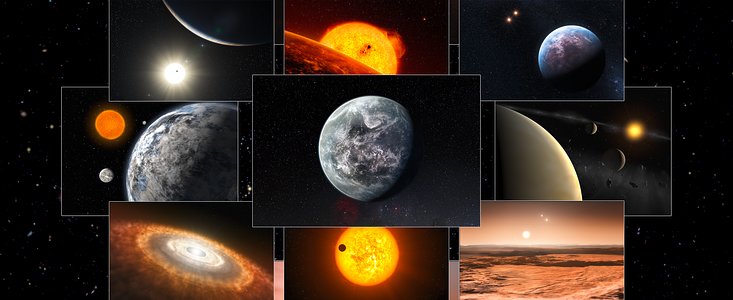Announcement
A Decade of Successful Planet Hunting
HARPS celebrates its tenth birthday
18 September 2013
On 16-17 September 2013 a scientific meeting in Geneva entitled 10 Years of Science with HARPS celebrated a decade of full operation of the High-Accuracy Radial Velocity Planet Searcher (HARPS) — the world’s foremost planet hunter. The meeting paid tribute to the extraordinary scientific results HARPS has provided and the unrivalled window it opens onto one of the most exciting areas of current astronomical science — the search for and characterisation of planets around other stars.
HARPS — an instrument on ESO's 3.6-metre telescope at the La Silla Observatory in Chile — first officially started operation on 1 October 2003 and holds some impressive records in its field. It has discovered the least massive exoplanet ever measured, challenged theories of planet formation by finding exoplanets orbiting in the opposite direction to the rotation of their host star, found planets in the habitable zone of a nearby star and discovered hundreds of new exoplanets. In fact nearly two thirds of all confirmed exoplanets with masses less than that of Neptune [1] were discovered by HARPS. HARPS observations were also the first to demonstrate that low-mass planets are very common around stars similar to the Sun, with more than 30% of them hosting super-Earths or Neptune-mass planets [2].
The instrument has achieved all this and more by being the world’s most accurate exoplanet hunting machine. It finds planets by measuring the radial velocity of stars. In other words, it measures how fast an object is moving away from or towards us, and can do so so precisely that it can measure velocity changes of less than four kilometres/hour — about the average person’s walking speed [3]. This information can be used to find evidence of planets as they orbit their parent stars and then to derive the separation between a planet and its host star. This allows astronomers to work out how much energy is received by the planet, an important constraint for assessing the planet's habitability. This takes us one step further in the search for alien life.
At the meeting, organised by the Geneva Observatory, a distinguished group of astrophysicists including ESO Director General, Tim de Zeeuw discussed the highlights of HARPS’ life so far and the adventures it and its successors, still have to come.
Notes
[1] Neptune has a mass about seventeen times the mass of Earth.
[2] This result was subsequently confirmed by the Kepler mission.
[3] Due to the Doppler effect, this radial velocity change induces a shift of the star’s spectrum towards longer wavelengths as it moves away (called a redshift) and a blueshift (towards shorter wavelengths) as it approaches. This is the tiny spectral shift that HARPS can measure.
Contacts
Francesco Pepe
Observatoire de l’Université de Genève
Switzerland
Tel: +41 223 792 396
Cell: +41 79 302 47 40
Email: francesco.pepe@unige.ch
Stéphane Udry
Observatoire de l’Université de Genève
Switzerland
Tel: +41 22 379 24 67
Email: stephane.udry@unige.ch
Richard Hook
ESO Public Information Officer
Garching bei München, Germany
Tel: +49 89 3200 6655
Cell: +49 151 1537 3591
Email: rhook@eso.org
About the Announcement
| Id: | ann13075 |

